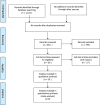Pericoronary fat attenuation index-a new imaging biomarker and its diagnostic and prognostic utility: a systematic review and meta-analysis
- PMID: 36069510
- PMCID: PMC9840478
- DOI: 10.1093/ehjci/jeac174
Pericoronary fat attenuation index-a new imaging biomarker and its diagnostic and prognostic utility: a systematic review and meta-analysis
Abstract
Pericoronary fat attenuation index (FAI) on coronary computed tomography angiography imaging has been proposed as a novel marker of coronary vascular inflammation with prognostic value for major cardiovascular events. To date, there is no systematic review of the published literature and no meta-analysed data of previously published results. We performed a systematic review and meta-analysis according to the Preferred Reporting Items for Systematic reviews and Meta-Analyses guidelines. We systematically explored published literature in MEDLINE (PubMed) before 20 January 2022 for studies assessing FAI in both diagnostic and prognostic clinical settings in patients with or without cardiovascular disease. The primary outcome was the mean difference in FAI attenuation between stable and unstable coronary plaques. The secondary outcome was the hazard ratio (HR) of high FAI values for future cardiovascular events. We calculated I2 to test heterogeneity. We used random-effects modelling for the meta-analyses to assess the primary and secondary outcomes. This study is registered with PROSPERO (CRD42021229491). In total, 20 studies referred in a total of 7797 patients were included in this systematic review, while nine studies were used for the meta-analysis. FAI was significantly higher in unstable compared with stable plaques with a mean difference of 4.50 Hounsfield units [95% confidence interval (CI): 1.10-7.89, I2 = 88%] among 902 patients. Higher pericoronary FAI values offered incremental prognostic value for major adverse cardiovascular events (MACEs) in studies with prospective follow-up (HR = 3.29, 95% CI: 1.88-5.76, I2 = 75%) among 6335 patients. Pericoronary FAI seems to be a promising imaging biomarker that can be used for the detection of coronary inflammation, possibly to discriminate between stable and unstable plaques, and inform on the prognosis for future MACE. Further validation of these findings and exploration of the cost-effectiveness of the method before implementation in clinical practice are needed.
Keywords: FAI; computed tomography; fat attenuation index; imaging; major adverse cardiovascular events; prevention; unstable plaques.
© The Author(s) 2022. Published by Oxford University Press on behalf of the European Society of Cardiology. All rights reserved. For permissions, please email: journals.permissions@oup.com.
Conflict of interest statement
Conflict of interest: None declared.
Figures




Comment in
-
Pericoronary adipose tissue attenuation: diagnostic and prognostic implications.Eur Heart J Cardiovasc Imaging. 2022 Nov 17;23(12):e537-e538. doi: 10.1093/ehjci/jeac175. Eur Heart J Cardiovasc Imaging. 2022. PMID: 36069116 No abstract available.
-
Assessment of pericoronary adipose tissue attenuation.Eur Heart J Cardiovasc Imaging. 2023 Mar 21;24(4):e57. doi: 10.1093/ehjci/jeac272. Eur Heart J Cardiovasc Imaging. 2023. PMID: 36680535 No abstract available.
References
-
- Mack M, Gopal A.. Epidemiology, traditional and novel risk factors in coronary artery disease. Heart Fail Clin 2016;12:1–10. - PubMed
-
- Virani SS, Alonso A, Benjamin EJ, Bittencourt MS, Callaway CW, Carson APet al. . Heart disease and stroke statistics-2020 update: a report from the American Heart Association. Circulation 2020;141:e139–596. - PubMed
-
- Malakar AK, Choudhury D, Halder B, Paul P, Uddin A, Chakraborty S. A review on coronary artery disease, its risk factors, and therapeutics. J Cell Physiol 2019;234:16812–23. - PubMed
-
- Kattoor AJ, Pothineni NVK, Palagiri D, Mehta JL. Oxidative stress in atherosclerosis. Curr Atheroscler Rep 2017;19:42. - PubMed

